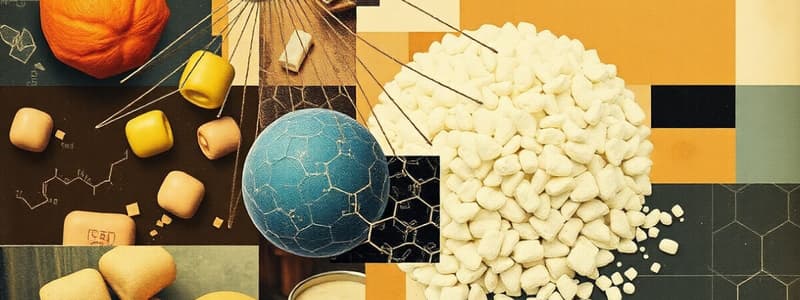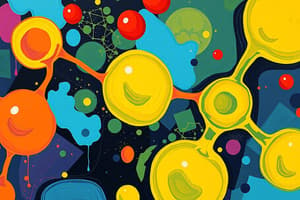Podcast
Questions and Answers
What is the defining characteristic of monosaccharides?
What is the defining characteristic of monosaccharides?
- They are carbohydrates made of more than 10 sugar molecules.
- They are derived exclusively from animal sources.
- They consist of two sugar molecules.
- They consist of a single sugar molecule. (correct)
Which of the following is a disaccharide?
Which of the following is a disaccharide?
- Starch
- Galactose
- Raffinose
- Lactose (correct)
What carbohydrate type consists of 3-10 sugar molecules?
What carbohydrate type consists of 3-10 sugar molecules?
- Disaccharides
- Polysaccharides
- Oligosaccharides (correct)
- Monosaccharides
Which of the following carbohydrates is most abundant in honey, fruits, and vegetables?
Which of the following carbohydrates is most abundant in honey, fruits, and vegetables?
Why is glucose significant for the human body?
Why is glucose significant for the human body?
What triggers the release of hydrochloric acid (HCL) during protein digestion?
What triggers the release of hydrochloric acid (HCL) during protein digestion?
What is the role of pepsinogen in protein digestion?
What is the role of pepsinogen in protein digestion?
What type of bond forms between two monosaccharides?
What type of bond forms between two monosaccharides?
What describes the process of deamination?
What describes the process of deamination?
Which of the following describes amylose?
Which of the following describes amylose?
Which statement accurately defines essential amino acids?
Which statement accurately defines essential amino acids?
Which mechanism is primarily involved in protein absorption through the brush border?
Which mechanism is primarily involved in protein absorption through the brush border?
What distinguishes glycogen from amylopectin?
What distinguishes glycogen from amylopectin?
Which glycosidic bonds are present in amylose?
Which glycosidic bonds are present in amylose?
Where is glycogen primarily found in the human body?
Where is glycogen primarily found in the human body?
What is a common feature of both amylose and amylopectin?
What is a common feature of both amylose and amylopectin?
Which type of bond occurs at the branching points in amylopectin and glycogen?
Which type of bond occurs at the branching points in amylopectin and glycogen?
How does glycogen compare to amylopectin in terms of structure?
How does glycogen compare to amylopectin in terms of structure?
What role does salivary a-amylase play in carbohydrate digestion?
What role does salivary a-amylase play in carbohydrate digestion?
What happens to amylase activity when food enters the stomach?
What happens to amylase activity when food enters the stomach?
How is glycogen primarily utilized in the body?
How is glycogen primarily utilized in the body?
Which hormone is released to lower blood glucose levels?
Which hormone is released to lower blood glucose levels?
What distinguishes lactose intolerance from a milk allergy?
What distinguishes lactose intolerance from a milk allergy?
What is a common symptom of lactose intolerance?
What is a common symptom of lactose intolerance?
What is the function of glucagon in the body?
What is the function of glucagon in the body?
Which population is more susceptible to lactose intolerance?
Which population is more susceptible to lactose intolerance?
What is the primary component that glycogen resembles in plants?
What is the primary component that glycogen resembles in plants?
What is the primary function of phospholipids in biological systems?
What is the primary function of phospholipids in biological systems?
How many calories are provided by triglycerides per gram?
How many calories are provided by triglycerides per gram?
What characterizes a saturated fatty acid?
What characterizes a saturated fatty acid?
Which type of fatty acid is characterized by having multiple double bonds?
Which type of fatty acid is characterized by having multiple double bonds?
What describes the arrangement of hydrogen atoms in a cis double bond?
What describes the arrangement of hydrogen atoms in a cis double bond?
Which type of fatty acid typically remains solid at room temperature?
Which type of fatty acid typically remains solid at room temperature?
What is the significance of the location of the first double bond in omega fatty acids?
What is the significance of the location of the first double bond in omega fatty acids?
What is the characteristic of fats derived from partially hydrogenated oils?
What is the characteristic of fats derived from partially hydrogenated oils?
What is a common effect of long-chain fatty acids compared to short-chain fatty acids?
What is a common effect of long-chain fatty acids compared to short-chain fatty acids?
Which type of fatty acid is liquid at room temperature and contains only one double bond?
Which type of fatty acid is liquid at room temperature and contains only one double bond?
What effect does chain length have on fatty acids?
What effect does chain length have on fatty acids?
What describes the general structure of lipids?
What describes the general structure of lipids?
What distinguishes trans fatty acids from other types?
What distinguishes trans fatty acids from other types?
Which of the following lipids is known for its role in energy storage?
Which of the following lipids is known for its role in energy storage?
Flashcards are hidden until you start studying
Study Notes
Carbohydrates
- Monosaccharides: single sugar unit, simple carbohydrate, examples: glucose, fructose, galactose
- Disaccharides: two sugar units, simple carbohydrate, examples: lactose, sucrose, maltose
- Oligosaccharides: 3-10 sugar units, complex carbohydrate, examples: raffinose, stachyose
- Polysaccharides: more than 10 sugar units, complex carbohydrate, examples: glycogen, starch, dietary fiber
- Glucose: most abundant monosaccharide in plants (fruits, vegetables, grains)
- Fructose: found in fruits, honey, highly processed foods with added sugars
- Galactose: primarily comes from lactose, found in dairy products
- Lactose: disaccharide composed of glucose and galactose
- Sucrose: most abundant disaccharide, found in honey, fruits, vegetables, table sugar (glucose + fructose)
- Maltose: disaccharide composed of glucose and glucose
- Glycosidic bond: chemical bond between two monosaccharides, formed when a hydroxyl group (-OH) from one monosaccharide interacts with a hydrogen group (-H) from another monosaccharide, forms one water molecule (H2O)
- Amylose: starch with a linear (unbranched) chain of glucose molecules, forms α-1,4 glycosidic bonds
- Amylopectin: starch with a highly branched chain of glucose molecules, forms α-1,4 glycosidic bonds in linear portions and α-1,6 bonds at branch points
- Glycogen: highly branched polysaccharide of glucose, found primarily in liver and skeletal muscles, forms α-1,4 glycosidic bonds in linear portions and α-1,6 bonds at branch points
- Glycogen, Glucagon, and Insulin: All involved in blood glucose regulation and energy storage
- Glycogen: storage form of glucose in the liver and muscles, providing energy
- Insulin: secreted by beta cells in the pancreas, lowers blood glucose levels by promoting glucose uptake and storage as glycogen
- Glucagon: secreted by alpha cells in the pancreas, increases blood glucose levels by stimulating glycogen breakdown in the liver
- Lactose Intolerance: lack of lactase enzyme, leading to digestive issues like gas, bloating, diarrhea, and cramps. Can be primary (aging), secondary (GI damage), or genetic. Common in certain ethnicities (Native American, African American, Asian American)
- Milk Allergy: immune system response to milk proteins, causing digestive issues (vomiting, diarrhea, abdominal pain, etc.), skin issues (hives, itching), respiratory issues, and potentially other symptoms.
- Diverticulosis: small pouches form in the lining of the colon, generally asymptomatic
- Diverticulitis: inflammation of the pouches, leads to pain, fever, changes in bowel habits, etc.
Protein digestion
- Gastrin: hormone triggers the release of hydrochloric acid (HCL) and pepsinogen
- HCL: disrupts protein structure (secondary, tertiary, quaternary), but not the primary structure
- Pepsinogen: an inactive proenzyme activated by HCL in acidic environment, converting to the active form pepsin
- Trypsin: pancreatic protein-digesting enzyme
- Deamination: breakdown of amino acids to produce lipids or glucose as needed, releases toxic ammonia (NH3)
- Transamination: transfer of an amino group from one amino acid to another, producing nonessential amino acids
- Essential Amino Acids: must be obtained through diet.
- Nonessential Amino Acids: can be synthesized by the body.
Lipids
- Fatty Acids: long chains of carbon atoms with hydrogen atoms attached.
- Triglycerides: glycerol molecule with three fatty acids attached, used for energy storage, insulation, and protection.
- Phospholipids: glycerol molecule with two fatty acids and a phosphate group, crucial for cell membrane structure.
- Sterols: diverse group of lipids with a complex ring structure, including cholesterol.
- Fat-soluble Vitamins: Vitamins A, D, E, and K.
- Saturated fatty acid: only single carbon-carbon bonds, mostly solid at room temperature (fats)
- Unsaturated fatty acid: one or more double bonds, mostly liquid at room temperature (oils)
- Monounsaturated fatty acid (MUFA): one double bond, semi-solid/thick liquid at room temperature
- Polyunsaturated fatty acid (PUFA): two or more double bonds, liquid at room temperature
- Cis double bond: hydrogen atoms on the same side of the double bond, leads to bends in the molecule.
- Trans double bond: hydrogen atoms on opposite sides of the double bond, creates a straighter molecule.
- HDL (High-density lipoprotein): "good Cholesterol", transports cholesterol from the body to the liver for excretion
- LDL (Low-density lipoprotein): "bad Cholesterol", transports cholesterol from the liver to the body, high levels contribute to cardiovascular disease.
Studying That Suits You
Use AI to generate personalized quizzes and flashcards to suit your learning preferences.




